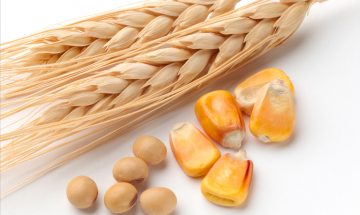Then it is already too late. Yellow, blue or white woolly mould growth on feed is a sure sign that valuable nutrients are quickly disappearing. Moulds are everywhere, and warm temperatures plus a humid environment provide optimal growing conditions. In the rainy season, feed spoils even quicker because of drastically higher moisture levels.

Figure 1: Multicoloured feed – a worrying sign of spoilage (Photo: Dr. Eckel)
However, even if feed does not appear to be affected, the mould count could still be elevated—with all the detrimental consequences that this entails for animal nutrition.
What makes mould control so important?
When moulds are left to grow unchecked, valuable nutrients—and money too—literally vanish into thin air in the rainy season every year. The nutritional quality of the feed, i.e. the starch, protein and energy content, deteriorates. Moreover, feed and food safety are at risk because moulds can produce mycotoxins, which pose a serious threat to both animal and human health.
MoldCid is the solution
Prevention is the key to avoiding nutrient losses and mycotoxin contamination due to mouldy feeds. A carbon dioxide test shows the efficacy of MoldCid in protecting your feed. As moulds grow, they consume oxygen from the air and produce carbon dioxide (CO2): the higher the amount of CO2, the higher the amount of mould in the substrate. Application of the propionic-acid–based MoldCid considerably decreases CO2 production in high-moisture feed, clearly indicating that MoldCid reduces microbial activity (Figure 2).

Figure 2: Effect of MoldCid on CO2 formation in an in-vitro preservation test with high-moisture feed
Protect your feed now
Timely intervention with MoldCid will stop mould growth in feed right from the start. Regular checks and attention to hygiene in the storage room will further help minimise the risk of spoilage during the rainy season.
Contribute to the production of healthy food by improving feed hygiene and protecting your feed with MoldCid. Reducing losses due to mould and preventing the build-up of mycotoxins will help you save raw materials, minimise costs and increase efficiency in food production. Contact us for more information.



